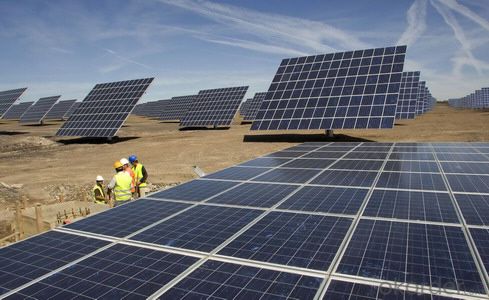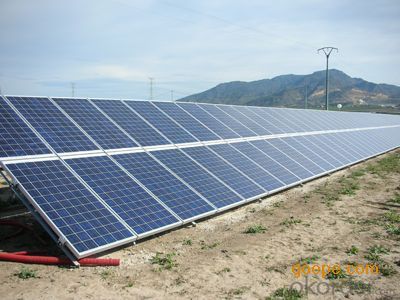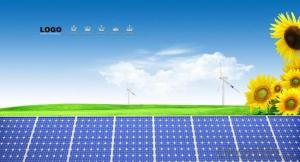Solar Module 230W Poly with High Efficiency of CNBM
- Loading Port:
- Shanghai
- Payment Terms:
- TT OR LC
- Min Order Qty:
- 11 watt
- Supply Capability:
- 111111 watt/month
OKorder Service Pledge
OKorder Financial Service
You Might Also Like
1.Structure of Solar Module Description
The solar module is an off-gird solar power generator, designed to provide stable and reliable electricity to homes and communities without access to grid electricity or to those regions where are short of power or even without power. The solar module is convenient to move, easy to set-up with reliable performance, making it ideal for situations where emergency power is required. It is an ideal & reliable energy source for a wide variety of applications, ranging from lighting , radios, fans ,televisions ,computers ,refrigerator. The USB port is compatible with all 5V-USB charged devices. It can also act as a back-up power source during emergency situations.
2.Main Features of the Solar Module
1).High conversion efficiencies resulting in superior power output performance.
2).Outstanding power output even in low light or high temperature conditions
3).Optimized design for ease of soldering and lamination
4).Long-term stability,reliability and performance
3.Solar Module Images


4.Solar Module Specification
230W Solar Module Polycrystalline -Competitive Quality, Price
TUV,CE,MCS,UL,CEC,IEC61215,61730,ISO9001,ISO 14001,VDE
Solar Module 230W Poly
Vmp:29.5V
Imp:7.8A
Voc:36.6V
Isc:8.42A
Pmax:230W
Operating Temperature:-40~+85°C
Maximum System Voltage:1000V DC
Maximum Series Fuse Rating: 15A
Module Efficiency: 14.1%
Power Tolerance:±3%
Mechanical Characteristics
Solar Cell: Polycrystalline 156*156mm(6 inches)
Dimensions:1650*992*50mm(64.95*39.05*2inches)
Weight:19.5KG(43.0lbs)
Front Glass: High Transparency Solar Glass 3.2mm(0.13inches)
Frame:Anodized Aluminium alloy(Siliver or Black)
Junction Box: IP 67 Rated(TUV&UL Approved)
Temperature Characteristics:
Nominal Operating Cell Temperature(NOC): 45±2°C
Temperature Coefficient of Pmax:-0.44%/°C
Temperature Coefficient of VOC:-0.33%/°C
Temperature Coefficient of Isc:0.055%/°C
Warranty:
10 years Product warranty
12 years 90% of power output
25 years 80% of Power output
5.FAQ of Solar Module
1). Q: Are you a factory or trading company?
A: We are a factory.
2). Q: Where is your factory located? How can I visit there?
A: Our factory is located in Jiangyin, Jiangsu, China, near Shanghai. You are warmly welcomed to visit us!
3). Q: How can I get some samples?
A: Please connect me for samples
4). Q: Can the price be cheaper?
A: Of course, you will be offered a good discount for big amount.
- Q:Can solar cells be used in remote areas with no access to electricity?
- Yes, solar cells can be used in remote areas with no access to electricity. Solar cells convert sunlight into electricity, making them a reliable and sustainable source of power in areas where grid connectivity is absent. They are particularly well-suited for remote locations due to their portability, low maintenance requirements, and ability to generate electricity even in harsh environmental conditions.
- Q:How do solar cells perform in high humidity environments?
- Solar cells can still perform well in high humidity environments. However, excessive moisture in the air can potentially reduce their overall efficiency.
- Q:How do solar cells perform in areas with frequent earthquakes?
- Solar cells can generally perform well in areas with frequent earthquakes as they do not have any moving parts and are not typically affected by ground vibrations. However, it is essential to ensure that the solar panels are properly installed and secured to withstand potential damages caused by seismic activities. Additionally, regular maintenance and inspections may be necessary to ensure the structural integrity of the solar system in earthquake-prone areas.
- Q:How do solar cells perform in areas with high levels of bird droppings?
- Solar cells may experience a decrease in performance in areas with high levels of bird droppings. The droppings can create a layer of dirt and debris on the surface of the solar cells, reducing their efficiency in converting sunlight into electricity. Regular cleaning and maintenance are necessary to ensure optimal performance in such areas.
- Q:How do solar cells perform in humid climates?
- Solar cells perform slightly less efficiently in humid climates compared to dry climates. This is because high humidity can reduce the amount of sunlight reaching the solar cells, scattering and absorbing some of the light. Additionally, moisture can accumulate on the surface of the cells, creating a barrier that decreases their performance. However, advancements in solar cell technology continue to improve their efficiency in humid conditions, making them still viable and effective in generating electricity.
- Q:What is a multi-junction solar cell?
- A multi-junction solar cell is a type of photovoltaic cell that consists of multiple layers of different semiconductor materials, each designed to absorb different wavelengths of sunlight. This allows the cell to convert a broader spectrum of light into electricity, resulting in higher efficiency and improved performance compared to traditional single-junction solar cells.
- Q:What happens to excess electricity generated by solar cells?
- Excess electricity generated by solar cells can be stored in batteries for later use, or it can be fed back into the grid to be used by other consumers.
- Q:Can solar cells be used in cold climates?
- Yes, solar cells can be used in cold climates. While they may not perform at their maximum efficiency in extremely cold temperatures, modern solar cell technology has advanced to be able to generate electricity even in low light and cold conditions. Additionally, snow on solar panels can be easily cleared to ensure proper functioning.
- Q:What materials are commonly used to make solar cells?
- Silicon is the most commonly used material for making solar cells. Other materials, such as cadmium telluride, copper indium gallium selenide, and perovskite, are also used in certain types of solar cells.
- Q:Can solar cells be used in water?
- Yes, solar cells can be used in water. Some solar panels are specifically designed to be used in water environments, such as floating solar panels used in reservoirs, lakes, and other bodies of water. These panels are waterproof and can efficiently generate electricity even when partially submerged.
1. Manufacturer Overview |
|
|---|---|
| Location | |
| Year Established | |
| Annual Output Value | |
| Main Markets | |
| Company Certifications | |
2. Manufacturer Certificates |
|
|---|---|
| a) Certification Name | |
| Range | |
| Reference | |
| Validity Period | |
3. Manufacturer Capability |
|
|---|---|
| a)Trade Capacity | |
| Nearest Port | |
| Export Percentage | |
| No.of Employees in Trade Department | |
| Language Spoken: | |
| b)Factory Information | |
| Factory Size: | |
| No. of Production Lines | |
| Contract Manufacturing | |
| Product Price Range | |
Send your message to us
Solar Module 230W Poly with High Efficiency of CNBM
- Loading Port:
- Shanghai
- Payment Terms:
- TT OR LC
- Min Order Qty:
- 11 watt
- Supply Capability:
- 111111 watt/month
OKorder Service Pledge
OKorder Financial Service
Similar products
New products
Hot products
Related keywords






























